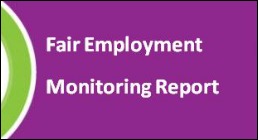
12/12/2013
Workforce monitoring figures based on returns from 2012 now available. See our Fair Employment Monitoring Report.
The Northern Ireland monitored workforce is closely mirroring the estimates of the community background of those available to work, the Equality Commission for Northern Ireland has stated today (Thursday December 12, 2013).
Commenting on the annual publication of the Fair Employment Monitoring Report, Michael Wardlow, Chief Commissioner said: “This is an encouraging picture of participation in the overall monitored workforce. We have seen for a number of years a steady improvement in the extent to which the representation of the Protestant and Roman Catholic community in the monitored workforce approximates to the composition of those available for work.”
The report, which is based on the monitoring returns from 127 public authorities and 3570 private sector concerns in 2012, shows that the Protestant share of the monitored workforce was [53.4%] and the Roman Catholic share was [46.6%].
This closely mirrors data from the Census and the Labour Force Survey estimates, which show Protestants make up around 53% and Roman Catholics around 47% of those available for work.
Dr Wardlow added: “Over time we can see that the gap between the composition of those in monitored employment and those available for work has narrowed. Using the census as a guide, back in 1991 the gap between Roman Catholics in the monitored workforce and those available for work was five percentage points. By 2011 this gap was around 1.3 percentage points.
“The monitored workforce data gives a consistent and coherent snapshot of the workforce, which now stretches back over two decades.
“What it cannot tell us is whether individual employers are providing fair participation, for example, or whether discrimination is occurring in specific instances.”
For the fourth successive year the proportion of applicants who were Roman Catholic [51.6%] was greater than the proportion who were Protestant [48.4%]. For appointees, the proportions were Roman Catholic [50.9%] and Protestants [49.1%].
As has been the case for some years now, women are more likely to be employed in the public than in the private sector. Female employment in the public sector (64.6%) was 18.7 percentage points higher than female employment in the private sector workforce (45.9%).
Women also represent 69.8% of all those in part-time employment. However, the proportion of men in part-time work has been increasing, rising from 25.8% in 2001 to 30.2% in 2012.
Dr Wardlow concluded: “The detailed figures and the overall findings drawn from the monitoring data can enhance the understanding of key developments in workforce composition. This year we are presenting the monitoring report as an electronic resource, providing accessible summary information supported by accessible and downloadable tables and charts We hope that this will be of help to everyone who is interested in equality of opportunity in the changing economic and demographic context of Northern Ireland today.
“The Equality Commission engages with employers in many ways apart from the annual monitoring exercise. Employers carry out comprehensive three yearly reviews under Article 55 of the Fair Employment and Treatment Order and, where significant under-representation has been identified, employers agree with the Commission to undertake programmes of affirmative action.”
ENDS
Note to Editor:
-
This year’s Monitoring Report (No.23) is available as an electronic resource on our website. It concentrates on the main findings for the overall Northern Ireland monitored workforce, the Private Sector, the Public sector; including six sub-sectors within the public sector.
-
There is also a summary version (pdf) of the report incorporating the main findings.
-
In addition, the key information is presented on a series of web pages alongside downloadable tables and charts, data on the composition of individual concerns and other recent relevant reports produced by the Commission on fair employment.
-
Watch the video interview of Chief Commissioner Michael Wardlow talking to economist John Simpson about improvements to the composition of the monitored workforce and the challenges ahead.D